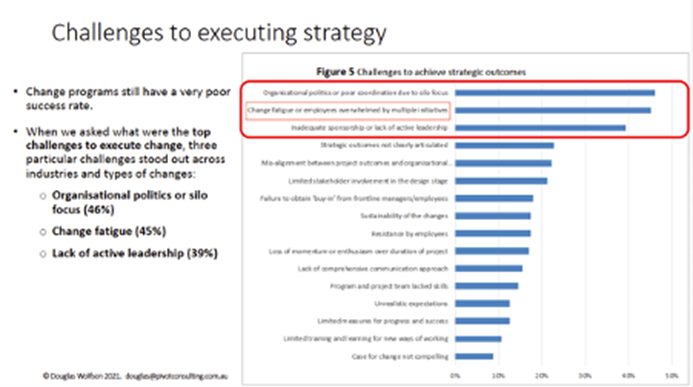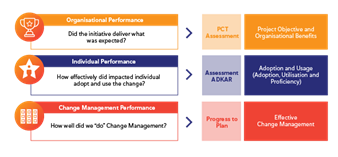The 9 best Change Management resources in June 2022
01 Jul 2022
Many great articles, posts, podcasts, webinars, videos and memes were published in June about Change Management.
Article written by Morten Kamp Andersen
01 Jul 2022
Many great articles, posts, podcasts, webinars, videos and memes were published in June about Change Management.
Article written by Morten Kamp Andersen
We continue to post the best change management articles, podcasts and videos each month. Because although our discipline is maturing, we need to continue to share our knowledge and experience with each other, so change management becomes the must-have recognised competitive advantage I think it is. And because work will be so much more fun if we make our necessary changes in the best possible way.
We have curated 9 resources, which are worth reading if you want to stay on top of what is going on in change management. Good reading…
This article was published in Harvard Business Review and is about how to lead in an era of constant change. The article is about that change is difficult — and managing through it might even be more challenging. Yet, with today's pace of change, CEOs have no choice but to be even more aggressive with their change efforts in order to stay competitive.
The author, Tim Ryan, suggests that to successfully lead their companies through change, today's CEOs must take four actions:
Sounds easy? Think again. It takes time, intentionality, and focus for a CEO and leadership team to become highly skilled in leading change and creating differentiation. It also takes a willingness to objectively, substantively, and persistently ask basic, but important, questions.
This article, which was published on Forbes' blog, is by Alexander Hagerup, co-founder and CEO of Vic.ai. He states that in business, as in all facets of life, nothing ever stays the same. Markets boom and bust, consumer tastes shift, and new technologies revolutionise even the most entrenched processes. Change can be incredibly positive. Change builds resilience, opens us up to new perspectives and creates opportunities we never saw coming. However, change can also be uncomfortable, and this discomfort feels especially pervasive during this era of rapid technological transformation. Entire industries are being disrupted by automation and artificial intelligence (AI).
Alexander continues to say that business leaders must do all they can to help their teams navigate these changes and understand the opportunities they present. He suggests that leaders must;
Change saturation is a common term used by change practitioners to describe when there may be too many changes being implemented at the same time. Pivot Consulting asked a range of different roles in organisations about implementing change. When questioned about key challenges to executing strategy and driving change, change fatigue or employees being overwhelmed by multiple initiatives is identified as one of the top 2 most critical challenges. It can be seen that change saturation is not just a popular discussion topic but a serious focus area that is posing significant challenges to a range of organisations.

Research from Pivot Consulting, 2020
There are many common ways of understanding and approaching change saturation. However, many of these are not always correct, with some being quite misleading. In this article, the authors review four incorrect assumptions about change saturation. I will only describe it briefly here, but I encourage you to read the full article.
Incorrect assumptions:
Kathryn Zukof is a learning and organisational development practitioner and educator with over 30 years of experience. She has a PhD in social psychology and an MBA in marketing. In this article, she describes best practices for planned change vs change in times of crisis.
Here are the best practices for managing planned change:
In a crisis, we have less time to react, but we still need sound change management. We may need to shift to techniques we can rapidly deploy, but these general principles of sound change management still apply:
In this article, Tim Creasey helps us connect change to business results using the 4P's exercise. Tim is Prosci's Chief Innovation Officer and a globally recognised leader in change management.
We often find that we must introduce change management to the stakeholders of a project. But how can we do that? Leveraging the 4P's—project, purpose, particulars and people—is a great way to help any audience see the connection between change management and achieving results. The 4 P's exercise is an activity you can complete anytime, anywhere to jumpstart a discussion on change management. All you need is a sheet of paper and an organisational project or initiative your audience cares about.
The goal is to demonstrate connections between the project, intended outcomes, and employee groups who will be impacted by the change effort while slowly and purposefully identifying four key elements of the change. The most important thing you can do is enable your audience to make this connection themselves. Although it sounds like common sense, the impact can be significant.
The article then goes on to describe the steps to complete the 4 P's exercise. At the headline level, they are:
We (people) are creatures of habits. Releasing pressure too quickly always places the whole initiative on a slippery slope. That's why sustainment might well be the most delicate and critical part of any change endeavour. Here is where the Prosci 3-phase change process comes in handy. Act on your performance reviews, activate the right roles, transfer ownership, and create change that sticks!
1. Review performance with PROSCI's tools - Key question: Now, where are we? Are we done yet?
Evaluation is a multi-layered process that targets three levels. Use different data and answer the following questions:

2. Activate sustainment with the right Change Management activities - Key question: How to ensure the change sticks?
Too many organisations jump straight to the next change, doing minimal reinforcement, if any at all. Cutting on Change Management resources – especially when reaching Phase 3 – is a sure way to jeopardise the whole change initiative.
3. Transfer ownership of the change - Key question: Who will assume ownership and sustain outcomes?
You can usually tell when something has become "business as usual". Alongside organisational performance results and overall employee satisfaction, anything that demonstrates that employees are proficient with the solution should indicate that the change is solidifying. It might involve low error rates, no or few questions asked new or extremely specific inquiries, and a sense that previous working processes were rather time-consuming and burdensome.
This Invensis video on "How to Incorporate Change Management in Agile? " will firstly explain what Agile Change Management is. Then, it explains in detail the ways of incorporating change management into agile and the benefits of change management.

Following is the outline of the video:
00:00:00 Introduction
00:01:54 What is Agile Change Management?
00:03:20 Ways of Incorporating Change Management into Agile
00:10:54 Benefits of Change Management
A picture can sometimes say more than an thousand words. The same with infographic. I have found two infographics here, which gave me some inspiration.
The first I found on Steve Salisbur’s LinkedIn page:

The second is from The Change Compass:

About episode 60: In this episode, we dive into making effective ERP organisational change through effective facilitation, including data-driven change, team engagement and action, change monitoring and evaluation.

Dr Jeanne Anderson is Professor Emerita at St. Cloud State University. Additionally, she is a Performance improvement specialist, change facilitator, and practitioner of problem-based learning and flipped instruction model. Jeanne specialises in community change, human performance technology, productivity improvement, data collection and analysis, and learning and organisational needs analysis. So let's learn more as we further explore these ideas with Jeanne.